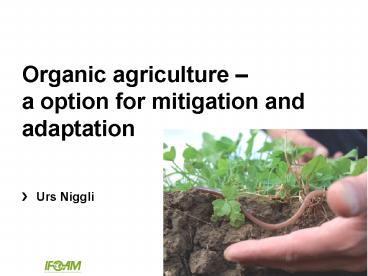Organic agriculture PowerPoint PPT Presentation
Title: Organic agriculture
1
Organic agriculture a option for mitigation
and adaptation
- Urs Niggli
2
Global GHG emissions of agriculture
3
Carbon sequestration in long term experiments
Niggli et al., 2009, FAO brochure
4
DOK long term comparision experiment,
Therwil/Switzerland
- running since 1978
- 7 year crop rotation (P-WW-Veg-WW-WB-GC-GC)
- 0 bio dynamic - organic - IP - conventional
- Loess soil, 833 mm precipitation, 9.4 ºC
temperature
Mäder et al. 2002, Science
5
GHG reduction and mitigation potential
Minimum Scenario todays organic
practice (100/200 kg C ha-1 yr-1) Optimum
Scenario organic farming and reduced
tillage 100/500 kg C ha-1 yr-1
Niggli et al., 2009, FAO brochure
6
Biodiversity on organic farms (global literature
review of comparison studies)
Taxon Positive Negative No difference
Birds 7 2
Mammals 2
Butterflies 1 1
Spiders 7 3
Earthworms 7 2 4
Beetles 13 5 3
Other arthropods 7 1 2
Plants 13 2
Soil microbes 9 8
Total 66 8 25
Hole et al., 2005
7
Organically managed systems more resilient to
climate change
- Adaptive management by community knowledge and
knowledge-intensive farming methods (Borron,
2006). - Resilience within agroecosystems
- Soils fertility building, physical soil
properties (Reganold, 1987, Mäder et al., 2002,
Pimentel et al., 2005). - Above and below ground macro and micro flora
fauna (Hole et al., 2005 Bengtsson et al, 2005). - Crop diversity in time and space
- Genetic diversity in crops (Kotschi, 2006).
8
Results of many case studies
- Improved food security by adopting OF as good
agricultural practice. - Case studies yield increases by 112 .
- Less dependent on expensive fertilizers,
pesticides and seeds. - Lower risks to run into debts.
- Access to high value markets (local and
international). - Knowledge-intensive agriculture.
UNEP-UNCTAD CBTF (2008).
9
Resource use efficiency (DOK trial, 28 years)
Parameter Unit Organic farming Integrated farming (IP) with FYM Organic in of IP
Nutrient input kg Ntotal ha-1 yr-1 101 157 64
kg Nmin ha-1 yr-1 34 112 30
kg P ha-1 yr-1 25 40 62
kg K ha-1 yr-1 162 254 64
Pesticides applied kg ha-1 yr-1 1.5 42 4
Fuel use L ha-1 yr-1 808 924 87
Total yield output for 28 years 83 100 83
Soil microbial biomass output tons ha-1 40 24 167
Mäder, Fliessbach, Niggli (2002), Science 296
10
Conclusions (1)
- Organic farming intensifies farm-internal
processes like biological activities of soils,
recycling of livestock and crop waste, enhanced
biodiversity as well as nitrogen fixation and
improved phosphorous availability by symbiosis. - Thus reliance on high energy external inputs is
reduced and less negative externalities occur.
11
Conclusions (2)
- Organic farming diversifies farm organization by
more complex crop rotations, by more farm
activities and by deploying more knowledge. - Thus, productivity gets higher in many cases,
yields are more stable and farms become less
vulnerable to climate change.
12
Conclusions (3)
- Organic farming builds up soil fertility and
increases or conserves soil organic matter. - Thus, supply and demand of nutrients get
synchronized, water and soils get conserved and
CO2 sequestered into the soil.
13
Conclusions (4)
- Organic farming is a relevant mitigation and
adaptation option in the context of climate
change. - Organic farming delivers many additional societal
benefits. - Organic farming is a viable solution for small
holder farmers in developing countrie
14
Consequences .
- Can organic agriculture feed the world?
- Less erosion a rate of 10 million hectare
annually (Pimentel, 1995) crucial for future
food security. - OF to recultivate poor soils and bring such soils
back into productivity. - Lower livestock densities and can compensate for
lower yields (land use 17 !). - Higher productivity by scientific agro-ecological
research?

